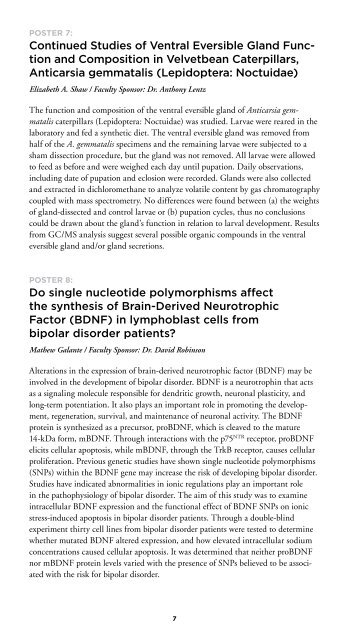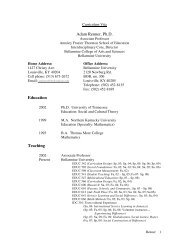College of Arts and Sciences - Bellarmine University
College of Arts and Sciences - Bellarmine University
College of Arts and Sciences - Bellarmine University
- No tags were found...
You also want an ePaper? Increase the reach of your titles
YUMPU automatically turns print PDFs into web optimized ePapers that Google loves.
Poster 7:Continued Studies <strong>of</strong> Ventral Eversible Gl<strong>and</strong> Function<strong>and</strong> Composition in Velvetbean Caterpillars,Anticarsia gemmatalis (Lepidoptera: Noctuidae)Elizabeth A. Shaw / Faculty Sponsor: Dr. Anthony LentzThe function <strong>and</strong> composition <strong>of</strong> the ventral eversible gl<strong>and</strong> <strong>of</strong> Anticarsia gemmataliscaterpillars (Lepidoptera: Noctuidae) was studied. Larvae were reared in thelaboratory <strong>and</strong> fed a synthetic diet. The ventral eversible gl<strong>and</strong> was removed fromhalf <strong>of</strong> the A. gemmatalis specimens <strong>and</strong> the remaining larvae were subjected to asham dissection procedure, but the gl<strong>and</strong> was not removed. All larvae were allowedto feed as before <strong>and</strong> were weighed each day until pupation. Daily observations,including date <strong>of</strong> pupation <strong>and</strong> eclosion were recorded. Gl<strong>and</strong>s were also collected<strong>and</strong> extracted in dichloromethane to analyze volatile content by gas chromatographycoupled with mass spectrometry. No differences were found between (a) the weights<strong>of</strong> gl<strong>and</strong>-dissected <strong>and</strong> control larvae or (b) pupation cycles, thus no conclusionscould be drawn about the gl<strong>and</strong>’s function in relation to larval development. Resultsfrom GC/MS analysis suggest several possible organic compounds in the ventraleversible gl<strong>and</strong> <strong>and</strong>/or gl<strong>and</strong> secretions.Poster 8:Do single nucleotide polymorphisms affectthe synthesis <strong>of</strong> Brain-Derived NeurotrophicFactor (BDNF) in lymphoblast cells frombipolar disorder patients?Mathew Galante / Faculty Sponsor: Dr. David RobinsonAlterations in the expression <strong>of</strong> brain-derived neurotrophic factor (BDNF) may beinvolved in the development <strong>of</strong> bipolar disorder. BDNF is a neurotrophin that actsas a signaling molecule responsible for dendritic growth, neuronal plasticity, <strong>and</strong>long-term potentiation. It also plays an important role in promoting the development,regeneration, survival, <strong>and</strong> maintenance <strong>of</strong> neuronal activity. The BDNFprotein is synthesized as a precursor, proBDNF, which is cleaved to the mature14-kDa form, mBDNF. Through interactions with the p75 NTR receptor, proBDNFelicits cellular apoptosis, while mBDNF, through the TrkB receptor, causes cellularproliferation. Previous genetic studies have shown single nucleotide polymorphisms(SNPs) within the BDNF gene may increase the risk <strong>of</strong> developing bipolar disorder.Studies have indicated abnormalities in ionic regulations play an important rolein the pathophysiology <strong>of</strong> bipolar disorder. The aim <strong>of</strong> this study was to examineintracellular BDNF expression <strong>and</strong> the functional effect <strong>of</strong> BDNF SNPs on ionicstress-induced apoptosis in bipolar disorder patients. Through a double-blindexperiment thirty cell lines from bipolar disorder patients were tested to determinewhether mutated BDNF altered expression, <strong>and</strong> how elevated intracellular sodiumconcentrations caused cellular apoptosis. It was determined that neither proBDNFnor mBDNF protein levels varied with the presence <strong>of</strong> SNPs believed to be associatedwith the risk for bipolar disorder.7
















